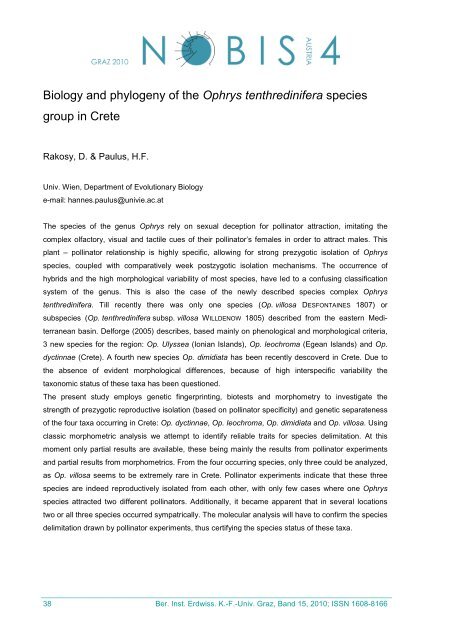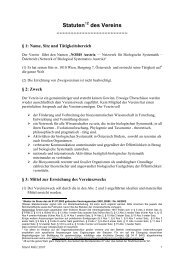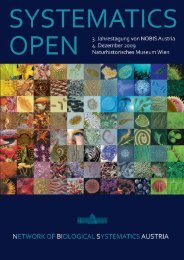4. Jahrestagung von NOBIS Austria 2. - 3. Dezember 2010
4. Jahrestagung von NOBIS Austria 2. - 3. Dezember 2010
4. Jahrestagung von NOBIS Austria 2. - 3. Dezember 2010
Create successful ePaper yourself
Turn your PDF publications into a flip-book with our unique Google optimized e-Paper software.
Biology and phylogeny of the Ophrys tenthredinifera species<br />
group in Crete<br />
Rakosy, D. & Paulus, H.F.<br />
Univ. Wien, Department of Evolutionary Biology<br />
e-mail: hannes.paulus@univie.ac.at<br />
The species of the genus Ophrys rely on sexual deception for pollinator attraction, imitating the<br />
complex olfactory, visual and tactile cues of their pollinator’s females in order to attract males. This<br />
plant – pollinator relationship is highly specific, allowing for strong prezygotic isolation of Ophrys<br />
species, coupled with comparatively week postzygotic isolation mechanisms. The occurrence of<br />
hybrids and the high morphological variability of most species, have led to a confusing classification<br />
system of the genus. This is also the case of the newly described species complex Ophrys<br />
tenthredinifera. Till recently there was only one species (Op. villosa DESFONTAINES 1807) or<br />
subspecies (Op. tenthredinifera subsp. villosa WILLDENOW 1805) described from the eastern Medi-<br />
terranean basin. Delforge (2005) describes, based mainly on phenological and morphological criteria,<br />
3 new species for the region: Op. Ulyssea (Ionian Islands), Op. leochroma (Egean Islands) and Op.<br />
dyctinnae (Crete). A fourth new species Op. dimidiata has been recently descoverd in Crete. Due to<br />
the absence of evident morphological differences, because of high interspecific variability the<br />
taxonomic status of these taxa has been questioned.<br />
The present study employs genetic fingerprinting, biotests and morphometry to investigate the<br />
strength of prezygotic reproductive isolation (based on pollinator specificity) and genetic separateness<br />
of the four taxa occurring in Crete: Op. dyctinnae, Op. leochroma, Op. dimidiata and Op. villosa. Using<br />
classic morphometric analysis we attempt to identify reliable traits for species delimitation. At this<br />
moment only partial results are available, these being mainly the results from pollinator experiments<br />
and partial results from morphometrics. From the four occurring species, only three could be analyzed,<br />
as Op. villosa seems to be extremely rare in Crete. Pollinator experiments indicate that these three<br />
species are indeed reproductively isolated from each other, with only few cases where one Ophrys<br />
species attracted two different pollinators. Additionally, it became apparent that in several locations<br />
two or all three species occurred sympatrically. The molecular analysis will have to confirm the species<br />
delimitation drawn by pollinator experiments, thus certifying the species status of these taxa.<br />
_____________________________________________________________________________<br />
38 Ber. Inst. Erdwiss. K.-F.-Univ. Graz, Band 15, <strong>2010</strong>; ISSN 1608-8166






